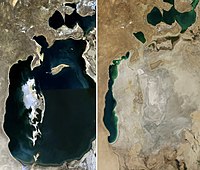
Photo from wikipedia
The ecological safety of Minqin oasis depends on the evolution of artificial Halxylon ammodendron communities that acts as important barriers and promotes the continual development of the oasis. The relationship… Click to show full abstract
The ecological safety of Minqin oasis depends on the evolution of artificial Halxylon ammodendron communities that acts as important barriers and promotes the continual development of the oasis. The relationship between artificial H. ammodendron communities and environmental factors was evaluated and analyzed using the quantitative ecology methods, two⁃way indicator species analysis ( TWINSPAN) and canonical correspondence analysis ( CCA) in this research. The results showed that (1) there were 4 types of associations in artificial H.ammodendron communities using TWINAPAN: AssociationI H. ammodendron + Nitraria tangutorum⁃Artemisia arenaria ⁃ Halogeton glomeratus; Association II H. ammodendron + Calligonum mongolicum ⁃ Agriophyllum squarrosum; Association III H.ammodendron + Nitraria tangutorum + Phragmites australis; Association IV H.ammodendron + Tamarix ramosissima +Kalidium foliatum. (2) The first axis of CCA ordination represented the environmental gradient of water and soil organic matter, meanwhile soil electrical conductivity was reflected by second axis of CCA ordination. Forward selection and Monte Carlo test suggested that the ordination of environmental factors determining species distribution of artificial H.ammodendron communites was soil water content(10%)>soil organic matter(9.7%) >pH(8.8%) >available phosphorus(8.4%) >sand(7.8%) >groundwater depth (7. 8%) > distance between oasis and desert ( 7. 2%) > total nitrogen ( 6. 9%) > electrical conductivity ( 6. 7%). The classification results of TWINSPAN were exactly reflected in the CCA two⁃dimensional ordination diagram for samples and environmental variables. (3) PCCA revealed that soil factors such as soil water content, organic matter, sand, electrical conductivity, available phosphorus, total nitrogen, pH, and groundwater factors together explained 19.8% of the variance in species distribution of artificial H. ammodendron communities. Soil factors alone explained 15. 6% of the variance, groundwater factors accounted for 1.1% of the variance, and the interaction between soil and groundwater factors explained 3.1% of the variance. The partitioning of variance using the PCCA helped identify the important habitat factors regulating species distribution of artificial H.ammodendron communities at the study site. However, the fact that more than half of the variance was unaccounted for by the factors studied suggested that other influences that were not examined could also play a role in determining the occurrence and distribution of artificial H.ammodendron communities, such as rain events, wind erosion, and sand burying, as well as banned and random events.
Journal Title: Acta Ecologica Sinica
Year Published: 2017
Link to full text (if available)
Share on Social Media: Sign Up to like & get
recommendations!